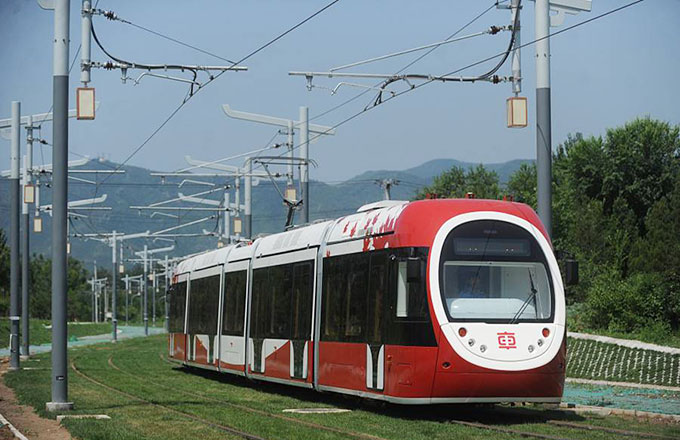Full text of Chinese Premier Li's speech at New Champions 2017 annual meeting opening ceremony
DALIAN -- Chinese Premier Li Keqiang on Tuesday delivered a speech at the opening ceremony of the Annual Meeting of the New Champions 2017, also known as the Summer Davos Forum, in Dalian.
The following is the full text of Li's speech:
Address by Premier Li Keqiang at the Opening Ceremony of Annual Meeting of the New Champions 2017
Dalian, 27 June 2017
Professor Klaus Schwab,
Your Excellencies Heads of Government,
Distinguished Guests,
Ladies and Gentlemen,
It's a great pleasure to meet you again in this beautiful city of Dalian. On behalf of the Chinese government, let me offer our warm congratulations on the opening of the Eleventh Annual Meeting of the New Champions, and extend a sincere welcome to all guests coming from afar and to members of the media.
Yesterday evening after my meeting with Professor Schwab and some of the delegates, we went to a viewing deck and enjoyed the sceneries around us. We saw green hills in the distance shrouded in a thin mist, which sometimes hid them from view. But it was only temporary. The mist eventually cleared away, and the mountain is always there. This scenery reminded me of the current state of the global economy. On the one hand, signs of world economic and trade recovery have begun to emerge and the new round of industrial revolution has given people new hope. Economic globalization has become an irreversible trend. On the other hand, global economic recovery remains weighed down by lack of growth drivers and structural imbalances that are yet to be fundamentally addressed. Backlash against globalization has worsened, compounded by rising geopolitical risks. If the hills represent stability of the global economy and the mist uncertainty, then stability will prevail over uncertainty as long as we harden our resolve and make relentless efforts.
In his keynote speech at the Annual Meeting of the World Economic Forum early this year, President Xi Jinping elaborated on China's firm commitment to economic globalization and free trade, which has been widely acclaimed by the international community. The theme of this annual meeting, "Achieving Inclusive Growth in the Fourth Industrial Revolution", is highly relevant to our times.
A review of world history shows that each of the industrial revolutions has brought about leapfrogging expansion of productivity and huge progress of civilizations in general. This round of industrial revolution, fostered in the era of economic globalization, is changing our world in a way unseen before in terms of speed, scope and depth of transformation, giving a strong boost to economic growth of all countries. However, if not managed properly, this round of change may also lead to lack of inclusiveness in growth. Some people may benefit more than others, traditional industries and jobs may take a hit, and returns on capital and labor may diverge further. Addressing these issues well is of both social and economic importance. Lack of inclusiveness will render part of the workforce and resources idle, and deepen the divide within society and between regions. This would hinder the tapping of market potential, aggravate the social divide, and make growth unsustainable. In contrast, inclusive growth makes societies fairer and development more widely beneficial. Realizing inclusiveness and achieving sustainable development are therefore two sides of the same coin.
Compared with the previous times, the new industrial revolution offers greater promise in fostering inclusive growth. Driven by Internet, digital and intelligent technologies, it has created new supply and demand, greatly expanded development space and brought unprecedented opportunities for equal participation. Now, it is much easier for anyone to log on the Internet to start a business, pursue innovation and create wealth. SMEs can get on the same starting point as big companies and foster new champions through integrated innovation. Developing countries can better leverage their comparative strengths and latecomer advantage. The key is to take vigorous and effective steps to turn these possibilities into reality and help more people, businesses and nations achieve greater progress in the new industrial revolution.
Promoting inclusive growth in our times calls for upholding economic globalization, which has greatly facilitated the flow of goods, capital and people, and provided bigger markets for producers and more choices for consumers than ever before. All countries are beneficiaries in this process. At the same time, countries, both developing and developed, have encountered challenges of different forms in adapting to economic globalization. However, these problems cannot be blamed on economic globalization per se. What is important is how to adapt or respond to it. To give an analogy, one cannot blame the uneven ground for his sprained ankle and stop walking altogether. Instead, we must better adapt to and steer economic globalization forward, uphold the authority and efficacy of the multilateral system, and promote investment and trade liberalization and facilitation. In the meantime, we need to reform and improve international economic and trade rules to secure equal rights, equal opportunities and equal rules for all countries in international economic cooperation.
Some people talk about the question of "fair trade". In fact, free trade, as the underlying driving force for economic globalization, is the prerequisite for fair trade. Restricting free trade will not make trade fairer. Fairness is an inherent requirement of free trade, and unfair trade will not be sustainable. When problems and trade disputes arise, it is advisable to take into account the national conditions of the other side, conduct consultation on the basis of equality and mutual accommodation, seek areas of converging and balanced interests and find win-win solutions through complementarity. All countries should be treated equally under international and multilateral rules. Imposing unilateral rules on others is much less advisable than pursuing all-win outcomes.
Promoting inclusive growth requires the hard work of countries themselves. Against the backdrop of economic globalization and new industrial revolution, a country's ability to seize the opportunities to speed up economic development and address challenges of unemployment, widening income gap and poverty is very much shaped by its own choices and actions. We should put in place better institutional arrangements incentivizing efficiency and equity, develop a model of balanced and inclusive growth, and provide opportunities for equal participation by all. We should make education future-oriented to help the workforce better adapt to industrial transformation, remove structural hindrances to employment, and give more support to vulnerable groups to enable all to benefit from development. Talking about sustainable development, one should not fail to mention responding to climate change, which is the shared responsibility of the international community. China will honor its commitments under the Paris Agreement and carry out climate response measures on the ground, as this is also required for China's green development.
Not long ago, China successfully held the Belt and Road Forum for International Cooperation. The Belt and Road Initiative, which follows the principles of extensive consultation, joint contribution and shared benefits, provides a wide platform for inclusive development and offers new opportunities for all countries and businesses. We look forward to the active participation of all sides for interconnected and win-win development through mutually beneficial cooperation.
Ladies and Gentlemen,
China has been an active facilitator of inclusive growth. More inclusive growth in our country has been an important reason why the Chinese economy has maintained steady growth in recent years despite the sluggish world economy. In keeping with the principles of innovative, coordinated, green, open and shared development and the trend of economic globalization and the new industrial revolution, we have highlighted inclusiveness in our development strategies, and worked to promote inclusive growth through providing institutional guarantee and policy support. This has helped us to blaze a path of inclusive growth with distinctive Chinese features. Naturally, we are still feeling our way forward along this path.
We have given priority to employment in pursuing development. Employment is the foundation for achieving inclusive growth. Without relatively full employment, inclusive growth would not be possible, and there would be no solid foundation for generating greater income and wealth. China has a workforce of over 900 million. Every year, about 13 million students graduate from colleges and secondary schools and a large number of rural surplus labor migrate to towns and cities. We see employment as a key indicator of economic performance and promoting steady growth is mainly for the purpose of securing employment.
We have implemented a proactive employment policy to boost total employment, address key employment issues and help vulnerable people. We encourage the creation of jobs by business start-ups. We have launched targeted employment programs for college graduates, supported migrant workers in starting up businesses back in their hometowns, and provided employment assistance to laid-off workers from industries with excess capacity, vulnerable urban residents and people with disabilities. The aim is to make sure that each family has at least one person on a stable job. Over the past few years, over 13 million new urban jobs have been created on a yearly basis, and surveyed urban unemployment rate has been kept at around 5%. A recent survey conducted by an authoritative international organization on various development indicators has ranked China's performance on employment at the very top of the world. In the meantime, people's income has been rising in tandem with economic growth, the Gini Coefficient is gradually going down and the ranks of middle-income earners have steadily swelled. This is a truly remarkable achievement for a major developing country with more than 1.3 billion people and an important contribution to inclusive growth.
We have encouraged more people to go for entrepreneurship and innovation. It also helps broaden the channel of employment. To make sure that everyone takes part, contributes and shares the benefits is the essence of inclusive growth. It is also what drives entrepreneurship and innovation in today's China. In recent years, China has earnestly implemented the strategy of innovation-driven development, and promoted mass entrepreneurship and innovation by fostering enabling conditions. These efforts have yielded better-than-expected results.
China's entrepreneurship and innovation are based on extensive public participation. Not only enterprises and research institutions are engaged in this effort, but more and more ordinary people are also joining in to make the best of their creative capabilities. This is aptly described by a Chinese idiom: Eight immortals crossing the sea, each with their own magical power. For the past three years since 2014 when we first put forward this initiative, an average of 40,000 new market entities have been set up every day, including some 14,000 newly registered enterprises. Business activity rate has stood at around 70%, and in May, the daily count of newly registered enterprises even reached 18,000.
China's entrepreneurship and innovation are driven by cooperation among different market entities. We have built open and sharing platforms of mass entrepreneurship and innovation, where innovation players of various kinds interact online and offline. Pooling their wisdom and efforts has made entrepreneurship and innovation more efficient, less costly and faster. The Global Innovation Index 2017 issued by the World Intellectual Property Organization and others a few days ago put China at 22nd place, 13 spots higher from 2013 and topping the middle-income economies. China's entrepreneurship and innovation have delivered benefits to all. The Chinese government has adopted an accommodating and prudent regulatory approach toward new industries, new business forms and models, such as e-commerce, mobile payment and bike-sharing, which have enabled their fast and healthy development. As a result, people's lives are made more convenient and a large number of jobs are created. Of all the new jobs created last year, about 70% were contributed by new growth drivers.
Mass entrepreneurship and innovation have given more people the opportunity to better their lives and thus improved opportunities for vertical social mobility. China's entrepreneurship and innovation have greatly advanced economic transformation and upgrading and raised our competitiveness. It has brought about fast growth of emerging industries and re-energized traditional ones, boosting new driving forces for development. Last year, the market value of China's sharing economy reached 3.5 trillion yuan, growing by more than 100% year-on-year, and 600 million people got involved in sharing. Thanks to the large population involved, China's entrepreneurship and innovation have gained a fast and strong momentum and provided an effective means to achieve inclusive growth.
We have continued to raise the standards of basic social welfare for our people. China is the world's biggest developing country. Meeting the basic needs of the over one billion people, such as subsistence, housing, education and medical care, is a huge challenge. Through painstaking efforts, China has put in place three social safety nets covering the entire population, i.e. basic pension, basic medical care and compulsory education. We have made utmost efforts to improve the living and working conditions of the low- and middle-income group, especially people living in poverty, and carried out major projects to improve people's livelihood, including rural poverty alleviation and rebuilding of run-down areas in cities. As a result of our efforts in the past 30 years and more, over 700 million Chinese have been lifted out of poverty, creating a Chinese miracle in the history of poverty reduction. We are now putting in targeted poverty alleviation efforts with the goal of taking the remaining 40 million rural poor out of poverty by 2020.
There used to be about 100 million people living in urban run-down areas in China. In the past eight years, we have invested over six trillion yuan in cumulative terms to ensure proper housing for over 80 million people by rebuilding more than 30 million run-down housing units. This is equivalent to housing the whole population of a relatively big country. Inclusive growth has delivered a better and more dignified life to our people and made our economy and society more dynamic and sustainable. That being said, China remains a developing country, and it still has a long way to go before the fruits of development can be shared among all its people and modernization realized.
Ladies and Gentlemen,
The Chinese economy has maintained a momentum of steady and sound growth this year. The first quarter saw 6.9% growth with marked improvement in economic performance, and major economic indicators have continued to move in a positive direction in the second quarter. Power generation, freight volume and new business orders have increased notably. Profits of industrial companies above the designated scale have increased at double-digit rates. Foreign exchange reserves have started to grow again, and the RMB exchange rate has been basically stable. In particular, employment has been strong with surveyed unemployment rate for urban areas falling to 4.91% in May, the lowest level in years. Citing the growing strength of new drivers and steady progress in economic rebalancing in China, a number of international organizations and research institutions have recently revised up China's growth forecasts, reflecting optimistic market expectations.
Pleased as we are with solid performance of economic indicators, we feel even more encouraged by valuable changes in our economic structure. In recent years, facing downward pressure, we did not resort to massive, indiscriminate stimulus measures or follow the previous pattern of excessive investment and resource consumption. Instead, we have kept readjusting our economic structure through reform and innovation and secured a major shift from too much reliance on export and investment to generating growth through consumption, the service sector and domestic demand. Last year, consumption became a primary growth driver, contributing 64.6% to economic growth; The added value of the service sector accounted for more than half, or 51.6% of GDP; Current account balance to GDP ratio dropped to 1.8%, showing that domestic demand has become a strong pillar of the economy. These major changes point to the qualitative improvement in the Chinese economy and have made our growth more stable and sustainable.
Having said that, we are also facing significant economic difficulties and challenges, which we are fully prepared to tackle. Given the complex and volatile external environment, short-term and marginal fluctuations of some economic indicators are inevitable at this crucial stage of transformation and upgrading of China's economy, but the overall trajectory of stability and growth will remain unchanged, and we are fully capable of fulfilling this year's main targets and tasks of development. We will stay committed to seeking progress while maintaining stability, accelerate economic transformation and upgrading through supply-side structural reform, and strengthen the internally-driven development.
We will deepen reform across the board and unleash greater dynamism of economic development. Reform will be stepped up in fiscal, taxation, financial, SOEs, state-owned asset and other key areas. Focus will be put on streamlining administration, delegating government powers, and cutting taxes and fees to lower institutional transaction costs and ease burdens on companies. Efforts will be made to expand market access, promote fair competition, provide better services, and remove investment and development barriers for private enterprises. Structural tax reduction policies will be implemented and charges on businesses overhauled. On top of the two trillion yuan worth of cuts in taxes and charges for businesses in previous years, we will introduce a further reduction of one trillion yuan this year, and make sure that market entities can truly feel the benefit of these measures.
We will continue to advance structural adjustments and accelerate the shift from old growth drivers to new ones. We will keep to innovation-driven development, seek greater progress in mass entrepreneurship and innovation, and push forward integrated innovation among large companies, SMEs, research institutions and makers. This will help foster new clusters of emerging industries, and encourage the transformation and upgrading of traditional industries with new technologies and new business forms. We will continue to cut excess capacity and phase out backward capacity in such areas as steel, coal and coal-fired power generation in a market- and law-based way. As China joins the ranks of middle-income countries, consumption is of crucial importance. Greater consumption will expand market potential in big ways and stimulate job creation. To upgrade consumption, we will keep improving the consumption environment, stimulate consumption demand and cultivate new areas of consumption. These measures will not only improve people's lives, but also provide new impetus to economic growth.
Proactive efforts will be made to expand opening-up and build a globally competitive business environment. We will move faster to develop a new, open economic system in keeping with economic globalization and the new industrial revolution. We will further ease market access in service and manufacturing sectors, relax foreign equity caps in some areas of interest, advance and improve the negative-list regulation model. Domestic and foreign companies are treated equally in the application of supportive policies. We will roll out measures to help them get registered at one-stop services and have their application handled within a time limit. We will encourage foreign-invested companies to reinvest their profits in China, support multinational companies in setting up regional headquarters in China, and encourage foreign investment in Central and Western China and old industrial bases such as Northeast China. In the coming five years, China will import US$8 trillion worth of goods. A Chinese economy which enjoys a sound momentum in the long run and becomes increasingly open will bring more opportunities to the rest of the world and remain the most attractive investment destination. We welcome businesses from across the world to invest in China and grow stronger with the Chinese economy.
We will step up efforts to prevent and control economic and financial risks and stave off systemic risks. Potential risks do exist in some areas, but they are generally under control. We are taking effective measures to tackle and remove them in a timely way. For China, the biggest risk is that of stalling growth. We will continue to take coordinated measures to prevent and address risks in the course of promoting economic development. With a relatively low government debt ratio among major economies and a relatively high savings rate, capital adequacy ratio of commercial banks and provision coverage ratio, we are fully capable of fending off risks and ensuring that the economy performs within a reasonable range, maintains medium-high growth rate and moves to the medium-high level.
Ladies and Gentlemen,
As a Chinese saying goes, "The sea is vast as it admits all rivers." An inclusive world will be a more splendid place. We are ready to work with all countries to achieve inclusive growth in economic globalization and the new industrial revolution, build a community of shared future, and create an even brighter tomorrow for mankind.
To conclude, I wish this Annual Meeting a complete success.
Thank you.
- President Xi says CICA meeting to contribute to regional peace
- Free trade 'good medicine' for global recovery: Premier Li
- China's Internet Plus plan welcomes global participation: premier
- China, US inseparable community of shared interests: Premier Li
- China contributes to solving global capacity glut: premier





















